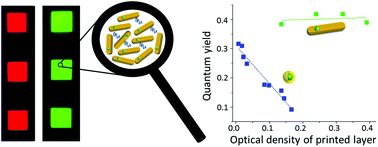Inkjet printed fluorescent nanorod layers exhibit superior optical performance over quantum dots†
Abstract
Semiconductor nanocrystals exhibit unique fluorescence properties which are tunable in size, shape and composition. The high quantum yield and enhanced stability have led to their use in biomedical imaging and flat panel displays. Here, semiconductor nanorod based inkjet inks are presented, overcoming limitations of the commonly reported quantum dots in printing applications. Fluorescent seeded nanorods were found to be outstanding candidates for fluorescent inks, due to their low particle–particle interactions and negligible self-absorption. This is manifested by insignificant emission shifts upon printing, even in highly concentrated printed layers and by maintenance of a high fluorescence quantum yield, unlike quantum dots which exhibit fluorescence wavelength shifts and quenching effects. This behavior results from the reduced absorption/emission overlap, accompanied by low energy transfer efficiencies between the nanorods as supported by steady state and time resolved fluorescence measurements. The new seeded nanorod inks enable patterning of thin fluorescent layers, for demanding light emission applications such as signage and displays.


 Please wait while we load your content...
Please wait while we load your content...